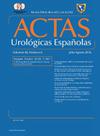Detección molecular y relevancia clínica de Haemophilus spp. en uretritis masculina: prevalencia y factores asociados
IF 1.2
4区 医学
Q3 UROLOGY & NEPHROLOGY
引用次数: 0
Abstract
Introduction and objective
Urethritis is the most common sexually transmitted infection in men. Haemophilus influenzae and Haemophilus parainfluenzae, commensal microorganisms of the respiratory and oral tract, have been proposed as potential etiological agents of non-gonococcal urethritis (NGU). This study aimed to determine the prevalence of these species in urine samples from men with urethritis and analyze their clinical correlation.
Methods
A total of 200 urinary DNA samples from patients diagnosed with urethritis were analyzed. Microorganisms were identified through multiplex PCR, amplifying the P6 and 16S rRNA genes. Associations between risk factors and infection were evaluated by calculating odds ratios (OR) and 95% confidence intervals (CI) using OpenEpi 3.03a.
Results
The mean age of the population was 55 years (range 20-95). Among the participants, 32.5% had received prior sexual education, and 75% reported not using contraceptive methods. H. influenzae was not detected in any sample, whereas H. parainfluenzae was present in 9.5% (n = 19) of cases. Significant associations were identified with the absence of formal education, a history of more than ten sexual partners, masturbation, and sexual intercourse under the influence of alcohol and/or drugs.
Conclusions
Although H. influenzae and H. parainfluenzae have been rarely identified in urethritis, their high transmissibility and clinical relevance suggest the need for their detection in high-risk populations. Their identification may contribute to improving diagnosis and the implementation of therapeutic strategies.

男性尿道炎中嗜血友病的分子检测和临床相关性:流行率和相关因素
前言与目的尿道炎是男性最常见的性传播感染。流感嗜血杆菌和副流感嗜血杆菌是呼吸道和口腔的共生微生物,已被认为是非淋球菌性尿道炎(NGU)的潜在病原。本研究旨在确定这些物种在尿道炎男性尿液样本中的患病率,并分析其临床相关性。方法对200例诊断为尿道炎患者的尿液DNA样本进行分析。通过多重PCR扩增P6和16S rRNA基因鉴定微生物。使用OpenEpi 3.03a软件计算优势比(OR)和95%置信区间(CI),评估危险因素与感染之间的关联。结果患者平均年龄55岁,年龄范围20 ~ 95岁。在参与者中,32.5%的人接受过性教育,75%的人没有使用避孕方法。在任何样本中未检测到流感嗜血杆菌,而在9.5% (n = 19)的病例中存在副流感嗜血杆菌。研究发现,缺乏正规教育、有10名以上的性伴侣、手淫以及在酒精和/或毒品的影响下发生性行为,与性行为有显著关联。结论虽然流感嗜血杆菌和副流感嗜血杆菌在尿道炎中很少被发现,但它们的高传播性和临床相关性提示有必要在高危人群中进行检测。它们的识别可能有助于提高诊断和治疗策略的实施。
本文章由计算机程序翻译,如有差异,请以英文原文为准。
求助全文
约1分钟内获得全文
求助全文
来源期刊

Actas urologicas espanolas
UROLOGY & NEPHROLOGY-
CiteScore
1.90
自引率
0.00%
发文量
98
审稿时长
46 days
期刊介绍:
Actas Urológicas Españolas is an international journal dedicated to urological diseases and renal transplant. It has been the official publication of the Spanish Urology Association since 1974 and of the American Urology Confederation since 2008. Its articles cover all aspects related to urology.
Actas Urológicas Españolas, governed by the peer review system (double blinded), is published online in Spanish and English. Consequently, manuscripts may be sent in Spanish or English and bidirectional free cost translation will be provided.
 求助内容:
求助内容: 应助结果提醒方式:
应助结果提醒方式:


